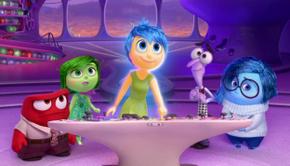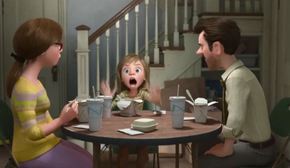 INSIDE OUT
INSIDE OUT
There appear to be two ideal ways to discuss, in review form, Pixar's hugely entertaining animated comedy Inside Out. One is through something short and sweet that suggests the experience of director Pete Docter's hilarious, incredibly sophisticated charmer without giving away all of its best jokes and most trenchant observations. The other is through a dissertation of some 20,000 words that digs deeply into the rather staggering psychological nuance of this thing, with lengthy footnotes exploring, say, The Role of Abstract Thought in the Prepubescent Female Psyche, or The Singular Comedic Melancholia of Phyllis from The Office. I'm opting for short(-ish) and sweet. And you're welcome.
Generally speaking, movies in the Pixar catalog are so brainy that it was almost frightening to contemplate one that was mostly set in the brain, but Inside Out, at least in narrative terms, is straightforward business. Eleven-year-old Riley (Kaitlyn Dias) and her parents (Diane Lane and Kyle MacLachlan) have just moved from Minnesota to San Francisco, and at first, all is well with both Riley and Joy (Amy Poehler), the principal emotion guiding the girl's moods from her interior command center. The relentlessly chipper, optimistic Joy - vocalized by Poehler as the personification of a sunbeam - serves as the Captain Kirk to an Enterprise crew of conflicting emotions: the squat, literally fiery Anger (Lewis Black); the rubber-limbed nebbish Fear (Bill Hader); the sarcastically dismissive Disgust (Mindy Kaling); and the blue-hued Sadness (Phyllis Smith), an exhausting mope who initially, and ruefully, seems to have no function aside from ruining everyone else's good time.
But everyone seems reasonably contented in their agreeable, occasionally argumentative workplace (which is fitting given the staff's Parks & Recreation and The Office veterans), and Riley seems content, too, even though she's picking up hints from her folks that the relocation, and Dad's job, may not be all they were cracked up to be. And then it happens: In the midst of introducing herself to her classmates on the first day of school, Riley shares a memory of life in Minnesota - a happy memory - and cries. It turns out that, without knowing how or why she did it, Sadness touched Riley's joyous remembrance and caused it to become a heartbreaking one, sending Joy and the others into panic mode. Joy attempts to jettison Riley's foul feelings from her brain, but instead succeeds in getting herself and Sadness jettisoned far, far away from the girl's consciousness. The dangerously unqualified Anger, Fear, and Disgust are left to control Riley's emotions. And while Joy and Sadness attempt the long and treacherous journey back to Riley's cerebral cortex (I guess), Riley herself grows more and more sullen, confused, and isolated, and gradually loses touch with all of the personality traits - her love of hockey, her streak of goofiness, et cetera - that made her, in her parents' words, "our happy little girl."
 In a nutshell, once the plot kicks into high gear, Inside Out is a simple beat-the-clock comedy in which Joy and Sadness have to get home before before their destructive co-workers cause permanent damage, and Riley is no longer recognizable as the girl she was. Even the youngest of grade-schoolers should be able to follow that storyline, and the dynamic colors, ingenious sound effects, and energetic (or, in Smith's case, aggressively non-energetic) vocal performances should handily hold their interest even if and when the script's niceties sail over their heads. But with the possible exception of the Cars pictures, the films in the Pixar oeuvre have always been not-so-secretly geared more toward adults than children, and it's nearly impossible to imagine any grown-up viewer of Docter's sublime achievement not finding more to love here than their youthful chaperones will.
In a nutshell, once the plot kicks into high gear, Inside Out is a simple beat-the-clock comedy in which Joy and Sadness have to get home before before their destructive co-workers cause permanent damage, and Riley is no longer recognizable as the girl she was. Even the youngest of grade-schoolers should be able to follow that storyline, and the dynamic colors, ingenious sound effects, and energetic (or, in Smith's case, aggressively non-energetic) vocal performances should handily hold their interest even if and when the script's niceties sail over their heads. But with the possible exception of the Cars pictures, the films in the Pixar oeuvre have always been not-so-secretly geared more toward adults than children, and it's nearly impossible to imagine any grown-up viewer of Docter's sublime achievement not finding more to love here than their youthful chaperones will.
I'm thinking of detours such as Joy's and Sadness' trek through Abstract Thought, where they turn into cubist representations of themselves, or the comic horrors of Riley's subconscious, which boasts the skyscraper-sized nightmare figures of Jangles the Clown and Grandma's Vacuum Cleaner (and proves even more discomforting than the subconscious of Being John Malkovich). There's the casual deletion of old memories such as phone numbers ("They're in her phone!") and songs from piano lessons ("Save 'Chopsticks' and 'Heart & Soul' and ditch the rest."), and the moment when Joy accidentally knocks over boxes of contents labeled "Facts" and "Opinions," and is told, "Eh, it doesn't matter - just mix 'em together." There's Riley's nearly forgotten imaginary friend Bing Bong, voiced with Richard Kind's peerless sad-sack-ery, and perhaps, for adults, the Pixar canon's most poignant creation yet.
And through the whole of this brilliantly inventive animated outing, without ever sacrificing narrative engagement or honest emotion, Docter and his trio of co-screenwriters deliver countless, gut-wrenching profundities on everything from the gradual erosion of memory to the inherent bond between joy and sadness - lower-cased and capitalized. Heaven knows you'll laugh a lot at Pixar's latest; the brief forays into Mom's and Dad's (and others') brains are beyond riotous, and there's a repeated gum-commercial jingle that serves the same purpose, and is just as funny, as the "Squirrel!" routine in Up. But also be prepared to find Inside Out 2015's most intensely moving feature to date. I rarely pop for 3D versions of movies these days, but did for this one, and it was worth it. The eyewear at least made my bawling a bit less obvious.










